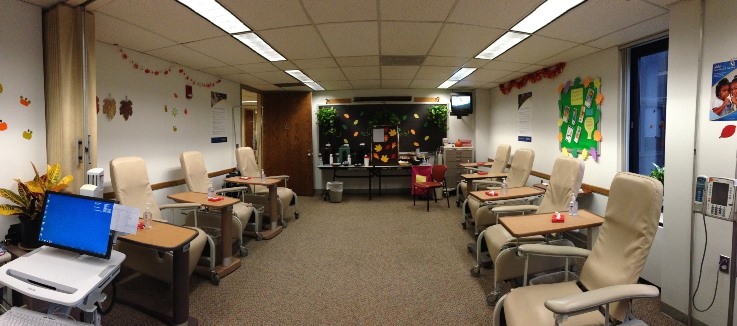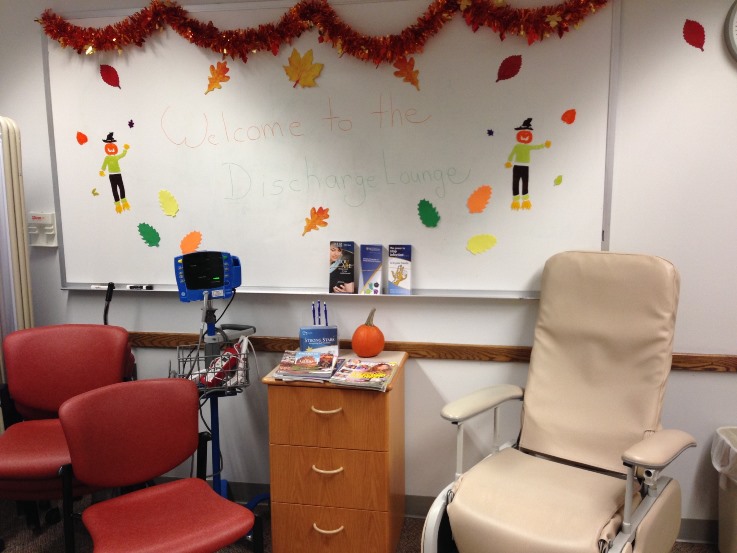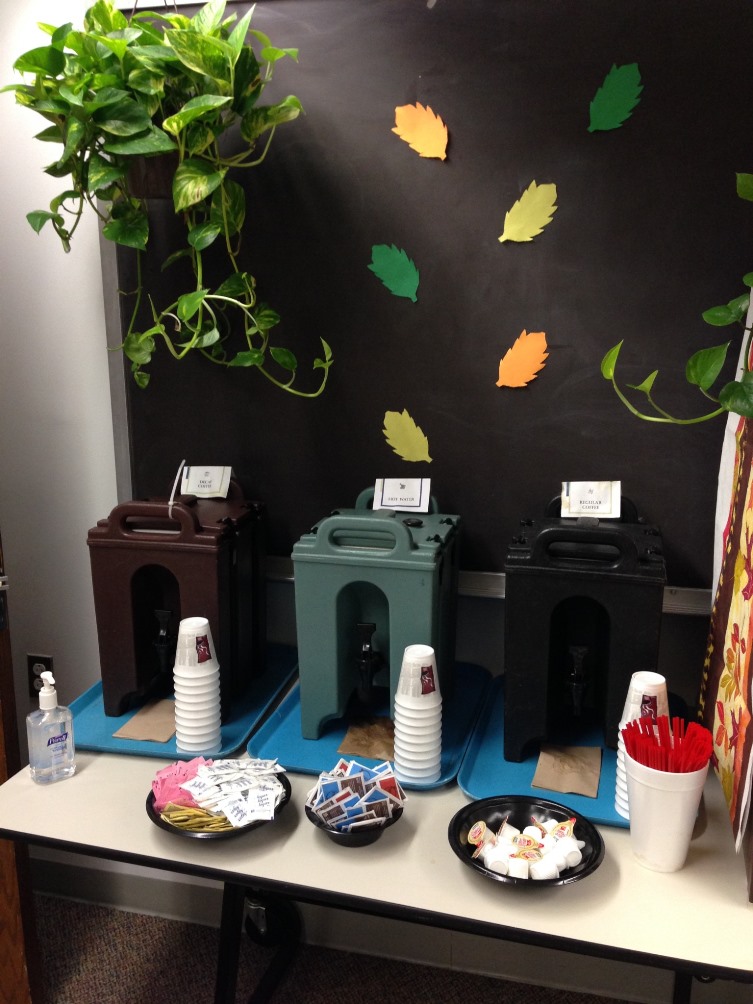Patient Discharge Lounge Sparks Connections, Frees Up Beds
 “Patients end up not wanting to leave.” That’s what Laurel Pye, nurse manager on Strong Memorial Hospital’s Surgical Trauma floor, has noticed about the Patient Discharge Lounge.
“Patients end up not wanting to leave.” That’s what Laurel Pye, nurse manager on Strong Memorial Hospital’s Surgical Trauma floor, has noticed about the Patient Discharge Lounge.
The lounge first opened its doors on the sixth floor in January 2014 as a pilot based on a high hospital census (in other words, a high demand for beds), and Pye was tasked with gathering the resources to get it off the ground. In April, the lounge closed temporarily so that Pye’s team, alongside UR Medicine’s Lean team, could step back, analyze the situation, and brainstorm improvements. Newly bolstered, the lounge reopened in October—with the aim of staying open indefinitely—to welcome patients.
Boosting the patient experience here is of course a top priority, as is increasing the hospital’s efficiency and making the most of our capacity. The lounge is in part a response to the Emergency Department’s overpopulation challenge. (At times, 40-plus patients have waited in the ED for an inpatient room.) How could we move ED patients into the hospital faster? Digging a layer deeper to the root of the issue: How do we free up inpatient beds quicker to accommodate the ED admissions?
Try breaking apart the four- to five-hour discharge process—one whose every piece has its own potential complications to contend with—and ushering patients who don’t need their beds anymore to another locale. This is just what Pye and her team did, respecting the delicate dance of seeing that a departing patient’s medical, insurance, pharmaceutical, and transportation needs are met. Indeed, dealing with these details and the waiting can be tedious, and folks get antsy. Pye has found, though, that physically moving patients from their rooms to the lounge helps them understand they’re moving through the process.
 Helping patients move through the discharge process is what you’ll find Marianne Cook, RN, busy doing. She coordinates and staffs the lounge. With 21 years of experience at Strong, and 30 as a nurse, Cook’s background includes time in the Emergency Department, where she witnessed the need to keep patients moving through the hospital system. She remembers the burden backup in the process flow placed—and continues to place—on staff as well as patients.
Helping patients move through the discharge process is what you’ll find Marianne Cook, RN, busy doing. She coordinates and staffs the lounge. With 21 years of experience at Strong, and 30 as a nurse, Cook’s background includes time in the Emergency Department, where she witnessed the need to keep patients moving through the hospital system. She remembers the burden backup in the process flow placed—and continues to place—on staff as well as patients.
The effort is paying off. As of Dec. 19, 148 patients total had used the lounge, freeing up approximately 214 hours in inpatient beds.
In the repurposed conference room (open Monday through Friday, 9:30 a.m. to 5 p.m.—closing time can be pushed a little later if necessary), as patients make their way out of the hospital, the high spirits can make for a chatty atmosphere that hints at the relief and relaxation these patients might be feeling. They come to the lounge, maybe even with one of their visitors. They sit and talk about what landed them in the hospital, how the stay was—or maybe about how their lives will be now. They bond and dawdle over goodbyes.
Making the Move
Transferring to the lounge is optional, but education efforts are underway to ensure the unit nurses throughout the hospital are aware of this resource and the prerequisites.
The space is intended for most of our adult patients, although there are standards in place for admission to the lounge. For example, patients must be continent and able to walk to the bathroom; they must be competent and alert and negative for C. diff infection and flu; they have to be steady (to prevent falls).
It’s up to the home unit’s nurses to notify the lounge when a patient who meets the criteria is approved for discharge and ready to be transferred to the lounge. The electronic medical record system has a “Ticket to Ride” feature that helps ensure an appropriate and safe handoff, providing Cook with pertinent information about the patient.
 On any given day, up to nine patients come and go. Outfitted with such creature comforts as recliner chairs and accompanying tables, privacy screens, a fridge for snacks and drinks (refreshed by Food and Nutrition Services), and a T.V., its big windows offer a glimpse of the outside—where some patients, maybe, haven’t ventured in recent days. Cook is ready to administer meds, help with paperwork, continue patient care, and react should a need arise.
On any given day, up to nine patients come and go. Outfitted with such creature comforts as recliner chairs and accompanying tables, privacy screens, a fridge for snacks and drinks (refreshed by Food and Nutrition Services), and a T.V., its big windows offer a glimpse of the outside—where some patients, maybe, haven’t ventured in recent days. Cook is ready to administer meds, help with paperwork, continue patient care, and react should a need arise.
Making it happen
If you’re wondering what it takes to morph a conference room into a lounge, in a word, it’s cooperation. In this case, Pye coordinated with Infection Prevention (to scour the space and ensure it fully met code); Facilities and Services (to outfit the room); the Patient- and Family-Centered Care office; Social Work; our ambassadors (who escort patients there); and others to bring it to life. Individuals instrumental to the project were Jill Sheflin, administrative assistant to Pat Witzel, chief nursing officer at Strong; Jennifer Harris, senior clinical nurse specialist at Strong Memorial Hospital; Mark Ott, senior nurse manager in Critical Care Nursing at Strong; and Wendy Cellini, administrative assistant to the associate director of Adult Medical/Surgical Nursing at Strong.
And talk about pulling together and springing into action: The lounge existed in idea form only one Wednesday afternoon in January last year; Pye got a phone call that evening saying make it happen; and Thursday morning, two outgoing patients found themselves the lounge’s first guests. The second go-around was just as snappy.
Before they leave the lounge, patients are asked to complete a brief survey. Recent comments have ranged from, “Beautiful décor, very comfortable,” to “I couldn’t have been made to feel more important by Marianne.”
1/8/2015
You may also like